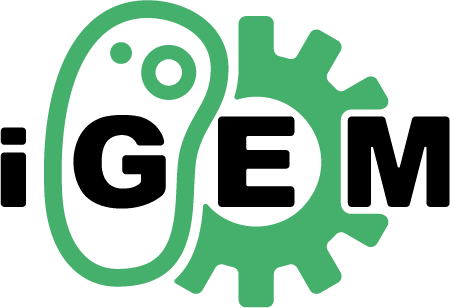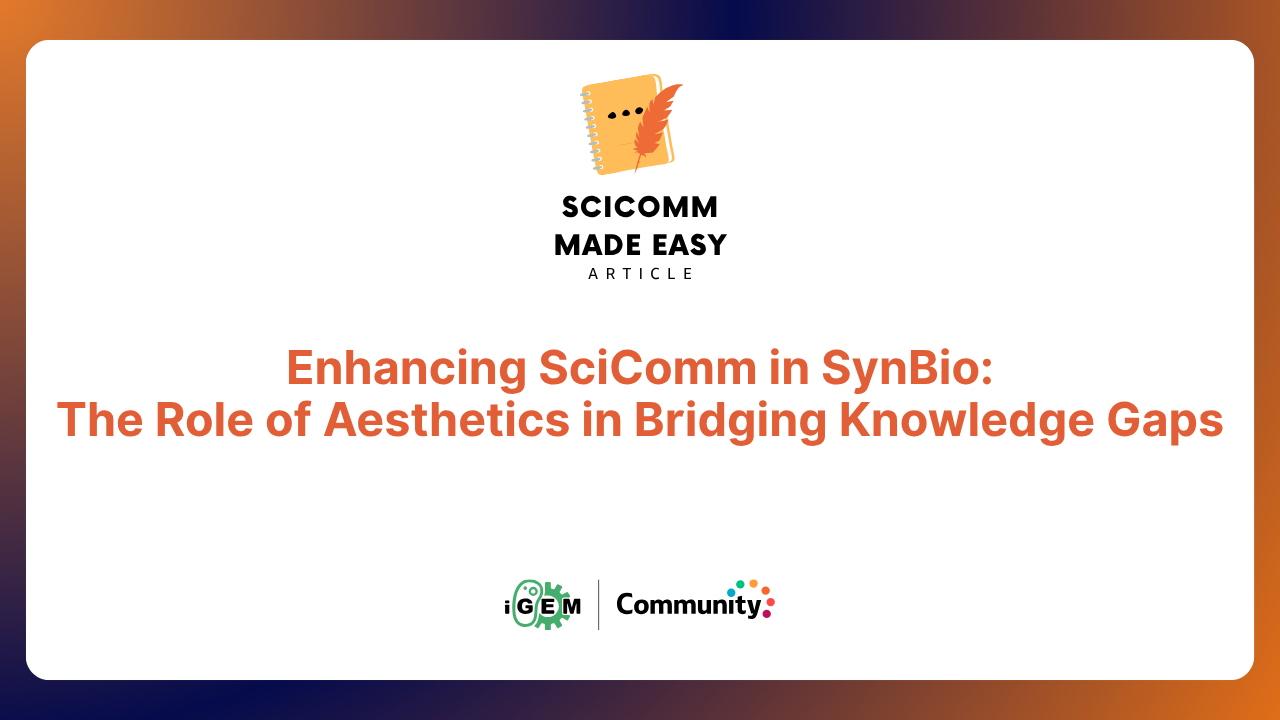Enhancing Science Communication in Synthetic Biology: The Role of Aesthetics in Bridging Knowledge Gaps
Written by: Chaimae Benkerdagh and Hazvinei Mang'anda
Edited by: Ankita De, Gokul Bhaskaran and Nayera Nasser
This article shares insights from the Mastering SciComm Course podcast (available on the iGEM Video Universe), and highlights how aesthetics can enhance science communication and help connect with diverse audiences.
Introduction
Synthetic biology is a branch of science that brings together biology, engineering and computer science. The British Society for Cell Biology defines synthetic biology as “the design and construction of new biological parts and systems, or the redesign of existing ones for useful purposes.”
However, public understanding of synthetic biology remains limited, and misconceptions can sometimes lead to negative perceptions of the field. Synthetic biology is highly complex, evolves rapidly and is often explained in ways that are difficult to follow. Moreover, there is a significant amount of misleading information online; for example, during the COVID-19 pandemic, widespread misinformation about vaccines and biotechnology occurred (Lynas, Adams & Conrow, 2022). As a result, public trust in scientists has declined. Effective science communication can help counter misinformation and restore trust.
Using visuals, plain language and creative tools can make synthetic biology more accessible and easier to understand. Below, we explore the challenges facing synthetic biology, and how the use of design and visual storytelling (aesthetics) can help make science clearer, more relatable and more engaging for everyone.
The challenge of communicating science to a broader audience
Scientists are often expected to be effective communicators simply because they are experts in their field. However, clear science communication is not easy. As scientific research becomes more specialized, and with many scientists receiving little formal training in communication, it can be challenging to explain complex ideas in simple, accessible terms. Topics such as gene editing are often laden with technical jargon, which make them even more difficult for the general public to understand. (Plantae, 2019) People come from diverse educational, cultural and age backgrounds, so science communication must be flexible and tailored to different audiences. Without relatable examples, science can feel distant, confusing or untrustworthy. Visual tools, in particular, can help make complex ideas in synthetic biology easier to understand, more relatable and more trusted by the public.
Why do visual aesthetics matter in science?
Visual aesthetics, or the use of appealing imagery, have a greater ability to capture attention compared to text alone. They enable clear and engaging representations that demystify science and aid in the understanding and assimilation of complex ideas. By presenting key information in digestible formats such as infographics, animations or even comics, aesthetics serve as a bridge that facilitates the spread of knowledge without oversimplifying the message.
How to appeal to different audiences?
Engaging with a diverse public means appealing and catering to their preferences. One way to do this is by playing with different visual styles. For example, scientists communicating their work can explore aesthetics ranging from minimalist, realistic and vintage, to futuristic design, depending on the audience and the message.
Fig 1. Designer Babies - CRISPR Explained (Kurzgesagt, 2016
The choice of colors plays a key role, too. It influences, for example, emotions and clarity. Using simple combinations, like complementary, analogous or triadic palettes help highlight key information and guide the viewer's eye.
Fig 2. Example of color scheme design (Dutcher, 2022)
Limiting a design to 2-3 main colors helps improve clarity (iGEM, 2023). It is also important to consider cultural meaning, and to ensure visual accessibility so the design resonates with diverse audiences and remains inclusive. Further explanation of these principles can be found in the segment titled “Colors Takes Practice” (starting at 12:15) in the video Basics of Science Illustration, created for the Mastering Science Communication course (iGEM, Basics of Science Illustration, 2023).
Digital tools for science communication
In today’s digital world, scientists have access to a range of tools that can help them communicate their work in a more visually compelling and accessible way. These tools can help create engaging science visuals. For example, BioRender is a user-friendly tool for scientific illustrations. Canva and SlidesGo are well-suited for creating posters and presentations. 3D visualization tools like Chimera, PyMOL and Yasara allow researchers to visualize molecular structures. AI tools can also generate images, but they must be used cautiously to avoid inaccuracies and ethical concerns like plagiarism. These issues have been highlighted in a previous blog by SciComm Made Easy entitled, “The Ethics of AI-Generated Scientific Research – Can AI Replace Scientists?”
Examples from iGEM Team projects where science meets creative design
The iGEM Competition has always been known for actively encouraging and urging young scientists to engage in good science communication. iGEM teams present their synthetic biology projects through several visually oriented submissions, like videos and posters. This allows and pushes participants across different fields to translate complex scientific ideas into appealing, accessible and engaging formats. These creative approaches are showcased on the iGEM Video Universe (iGEM, 2024), demonstrating how aesthetics and communication tools can truly bring science to life.
Aside from the final submissions, iGEMers also engage with local communities and stakeholders during the iGEM Competition season. This helps them improve their communication skills and makes science more inclusive and transparent. iGEM also values and encourages efforts at ongoing communication. Many teams share their progress through social media platforms like Linkedin, Instagram, Tiktok and Facebook, allowing them to open dialog with a broader audience.
With thoughtful design, color and creativity, science can become accessible and inspiring. Aesthetics in science communication go beyond mere appearance, they play a crucial role in making science comprehensible, engaging and memorable.
REFERENCES :
Lynas, M., Adams, J., & Conrow, J. (2022). Misinformation in the media: global coverage of GMOs 2019-2021. GM Crops & Food, 16(1), 1–10. https://doi.org/10.1080/21645698.2022.2140568
WEB RESOURCES :
British Society for Cell Biology. (n.d.). BlogByte: What’s in a name? Synthetic Biology. Retrieved April 8, 2025, from https://bscb.org/blogbyte-whats-in-a-name-synthetic-biology
iGEM. (2024). 2024 Project Promotions [Video collection]. iGEM Video Universe. https://video.igem.org/c/2024_project_promotions/videos?s=1
iGEM (2023) Basics of Science Illustration. iGEM Video universe.
https://video.igem.org/w/1FdEwJAD8eG6HuSsHqwGNf
Research Outreach. (2022). The Challenges of Communicating Synthetic Biology. Available at: https://researchoutreach.org/articles/machine-metaphors/
Plantae. (2019, October 10). Science communication and public understanding. https://plantae.org/science-communication-and-public-understanding/
Dutcher Katie, (2022) “Understanding Color Schemes and Choosing Colors for Your Website.” Web Ascender, Understanding Color Schemes & Choosing Colors for Your Website - Web Ascender
Kurzgesagt. (2016). Designer Babies - CRISPR Explaine, Behance. Designer Babies - CRISPR Explained :: Behance









